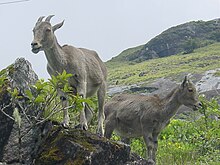Tahr

Various representatives of the goat-like species that are common in Asia are referred to as tahr . Originally they were united in the genus Hemitragus , but according to a study from 2005 the tahre belong to different genera. With the Himalayan tahr ( Hemitragus jemlahicus ) in the Himalayan region, the Nilgiri tahr ( Nilgiritragus hylocrius ) in southern India and the Arabian tahr ( Arabitragus jayakari ) on the Arabian Peninsula, the tahrs comprise a total of three species.
features

Tyres are of goat-like shape. They have a stocky torso, strong legs, and wide hooves, which makes them good climbers. These animals reach a head trunk length of 0.9 to 1.4 meters, a shoulder height of 0.6 to 1.1 meters and a weight of 50 to 100 kilograms, whereby the males are heavier than the females. The color of the fur is different depending on the species. The Himalayan Tahr has a long, red-brown to gray-brown fur that forms a thick mane in the neck area. The Arabian Tahr also has a longer, red-brown fur and a mane. The Nilgiri-Tahr has much shorter hair, its coloration varies depending on gender and age from yellow-gray to dark brown.
Both sexes have horns. These are bent back and often flattened to the side, but not twisted in a spiral like some goats. The horns of adult males are significantly larger than those of the females.
distribution and habitat
All three species of tahr inhabit rocky, rugged habitats. The Himalayan Tahrs tend to inhabit forest-covered mountainous regions, the Nilgiri Tiers are native to the grassy Nilgiri Mountains in southern India, and the Arabian Tiers live in the dry, vegetation-poor Hajar Mountains in the east of the Arabian Peninsula.
Way of life
Tahre are more crepuscular animals and often rest during the day in the protection of rocks or vegetation. Himalayan and Nilgiri Tahre live in herds, usually in separate groups of females and males; sometimes males are also loners. Only in the mating season do the males join the females and try to win the mating privilege by fighting among themselves. In contrast, Arab Tahrans live solitary or in small family groups.
Tahre are herbivores that feed primarily on grasses, wild herbs and leaves.
Danger
The destruction of the habitat and the often illegal hunting are the main threats to the tahrs. While the Himalayan tahr is still relatively common, the total population of the Nilgiri and Arabian tahr is estimated at around 2000 animals each - according to the IUCN , both species are endangered ( endangered ).
Systematics and naming
|
Internal systematics of the Caprini and position of the Tahre according to Bibi 2013
In Bibi 2013 the Nilgiri-Tahr was not taken into account and is added in its position after Robiquet and Hassanin 2005. |
The name "Tahr" comes from the Nepalese language . The scientific name Hemitragus comes from the Greek and literally means "half-goat".
According to molecular genetic analyzes by Anne Ropiquet and Alexandre Hassanin: In 2005 the Tahre are obviously not closely related. The study surprisingly revealed that the three species are each to be placed in the vicinity of very different genera. According to this, the Himalayan tahr is a relative of the goats , the Nilgiri tahr has been identified as a sister species of the sheep , and the Arabian tahr is close to the maned sheep . Accordingly, a common genus Hemitragus cannot be maintained, and the authors propose to establish two new genera: Nilgiritragus for the Nilgiri tahr , and Arabitragus for the Arabian tahr . Further studies support this result.
Trivia
The version 14.04 LTS of the computer operating system Ubuntu was christened “Trusty Tahr” (“Treuer” or “Reliable Tahr”).
literature
- Ronald M. Nowak: Walker's Mammals of the World . Johns Hopkins University Press, 1999 ISBN 0-8018-5789-9
- A. Ropiquet, A. Hassanin: Molecular evidence for the polyphyly of the genus Hemitragus (Mammalia, Bovidae) . In: Molecular Phylogenetics and Evolution 2005, No. 36 (1), pp. 154-168.
Individual evidence
- ↑ a b Fayasal Bibi: A multi-calibrated mitochondrial phylogeny of extant Bovidae (Artiodactyla, Ruminantia) and the importance of the fossil record to systematics. BMC Evolutionary Biology 13, 2013, p. 166
- ^ A b Anne Ropiquet and Alexandre Hassanin: Molecular evidence for the polyphyly of the genus Hemitragus (Mammalia, Bovidae). Molecular Phylogenetics and Evolution 36, 2005, pp. 154-168
- ↑ Alexandre Hassanin, Frédéric Delsuc, Anne Ropiquet, Catrin Hammer, Bettine Jansen van Vuuren, Conrad Matthee, Manuel Ruiz-Garcia, François Catzeflis, Veronika Areskoug, Trung Thanh Nguyen and Arnaud Couloux: Pattern and timing of diversification of Cetartiodactalia, Lauriala (Mammia ), as revealed by a comprehensive analysis of mitochondrial genomes. Comptes Rendus Palevol 335, 2012, pp. 32-50
Web links
- Endangerment level of the individual species in the IUCN Red List of Threatened Species .
